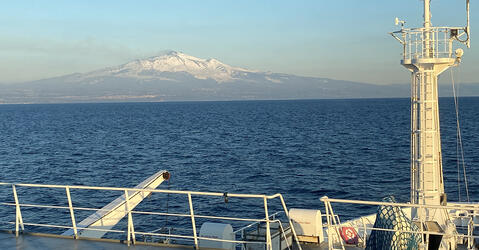You are here
Bouncing Lasers off the Moon
50 years ago, one voice reached across the depths of Space to leave its mark on history.
Niel Armstrong (U-S-A! U-S-A!)
On July 21st, 1969, 400,000km from earth, Neil Armstrong became the first human to set foot on the lunar surface. The world discovered this monochrome landscape through the footsteps left by Armstrong and Aldrin. Beyond the technical and political success represented by Apollo 11’s mission, it was an opportunity for the astronauts to gather samples and install devices for scientific measurements. In particular, they deployed a reflective panel no larger than a suitcase. 50 years later, it’s among the instruments that continue to supply the scientific community with data.
Return to earth, more precisely to the South of France. This plateau is the home of the Calern Observatory. Among the instruments directed towards space, one telescope in particular is studying the lunar surface, and has been for nearly half a century. With a 1,5 meter diameter mirror, this telescope is equipped with a laser which enables it to measure the distance between the Earth and the Moon with great precision. Every day, scientists from the observatory calculate the trajectories needed to find the reflectors left on the surface by the various Apollo missions. Over the years, this study has benefited greatly from technological advancements.
CLEMENT COURDE – PHYSICIEN
“50 years ago, measurements of this distance taken by laser were accurate to within about a meter. Thanks to the evolution of technology that followed, our measurements today are precise to within a few millimeters with an exactitude on the order of a centimeter. This exactitude is a little less than we’d like due to misreadings caused by atmospheric interference. We have a lot of studies currently centered on the impact of the atmosphere on our lasers, in order to compensate for these perturbations.”
On this June evening, Moonrise is predicted at around 11PM. After calibrating the various instruments that ensure the stability of this extremely powerful laser, the operating team will need to reorient it towards the Moon to begin collecting data. This laser, visible to the naked eye at night, produces ten pulses per second. Out of the thousands of photons bombarding the moon, few will return to Earth and be captured by the telescope. A round trip journey of roughly 800,000 km that takes 2.4 seconds to complete. The observer on Earth must continually and manually correct the telescope’s aim. In this way they will obtain an echo, the sign that the laser has succeeded in striking one of the reflectors left on the lunar surface.
CLEMENT COURDE – ALSO A RESEARCH ENGINEER APPARENTLY
“We use five reflectors on the surface of the Moon, three of which were deployed by the Americans on Apollo missions, the first being Apollo 11. It’s a panel which is 50cm squared and which was equipped with 100 corner-cube reflectors. Corner-cube reflectors are systems which, unlike regular mirrors, can reflect light back in the direction it came from. When one looks at this kind of object one will see the center of their own eye reflected back, which is exactly the kind of passive system used on the moon. There are three American reflective panels from Apollo 11, 14, and 15, as well as two Russian rovers, Lunokhod 1 and 2, which were also equipped with this type of system.”
Measurements collected by this observatory, in conjunction with an international network of observation stations, have improved the database which feeds the research of scientists around the world. Nicolas Rambaux, an expert in celestial mechanics, works at the Paris observatory. From these precise Earth-Moon distance readings, he was able to deduce the size and composition of the Moon’s core. It was formed 4.5 billion years ago but its internal structure has continued to evolve. Today the core is believed to be fluid, and Nicolas Rambaux and his team have recently estimated its diameter at 381km.
NICOLAS RAMBAUX – CELESTIAL MECHANIC (coolest job title ever) AKA ASTRONOMER
“What interests us most about the Moon’s core is its size and physical state. We want to generate information on its formation and, at the same time, better understand the appearance and disappearance of its magnetic field. So we have a lot of questions remaining about the internal structure of the Moon, notably whether the very center of its core is solid or fluid. We hope to draw more attention to this question and continue to develop models of the Moon’s nucleus. We’ll also continue our observations of Earth-Moon distance as measured by laser. Ideally, we’d like to see new retro-reflectors to the Moon’s surface to better measure the movement of its rotation.”
These lunar lasers have not only permitted the measurement of the distance between Earth and the Moon, but also the rate at which the Moon is distancing itself from our planet. The Moon’s orbit widens by 3.8cm every year and the impacts of this phenomenon are still open questions for the scientific community. Even if mankind was able to set foot on its surface 50 years ago, the Moon maintains mysteries that fascinate scientists to this day...
Bouncing Lasers off the Moon
Fifty years after Neil Armstrong and Buzz Aldrin's historic moonwalk, scientific instruments deployed on the Moon's surface continue to supply valuable data to scientists. Using these reflectors still in place on the Moon's surface, a team of researchers and engineers in France measure the Earth-Moon distance with millimetric precision.
GéoAzur
CNRS / Université Nice Sophia Antipolis / IRD / Observatoire de la Côte d’Azur
Nicolas RAMBAUX - Sorbonne Université
Institut de mécanique céleste et de calcul des éphémérides
CNRS / Observatoire de Paris / Sorbonne Université / Université PSL





